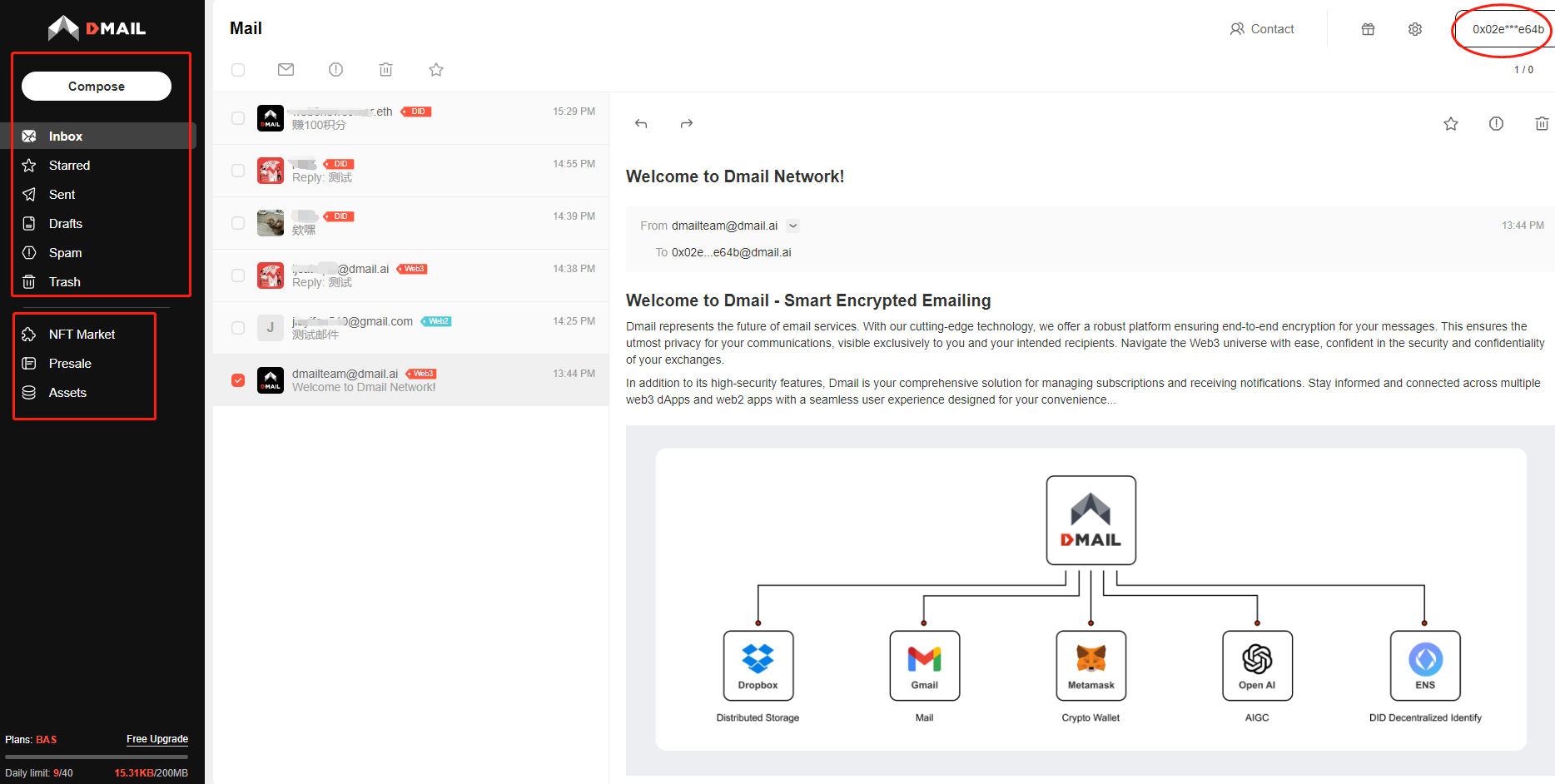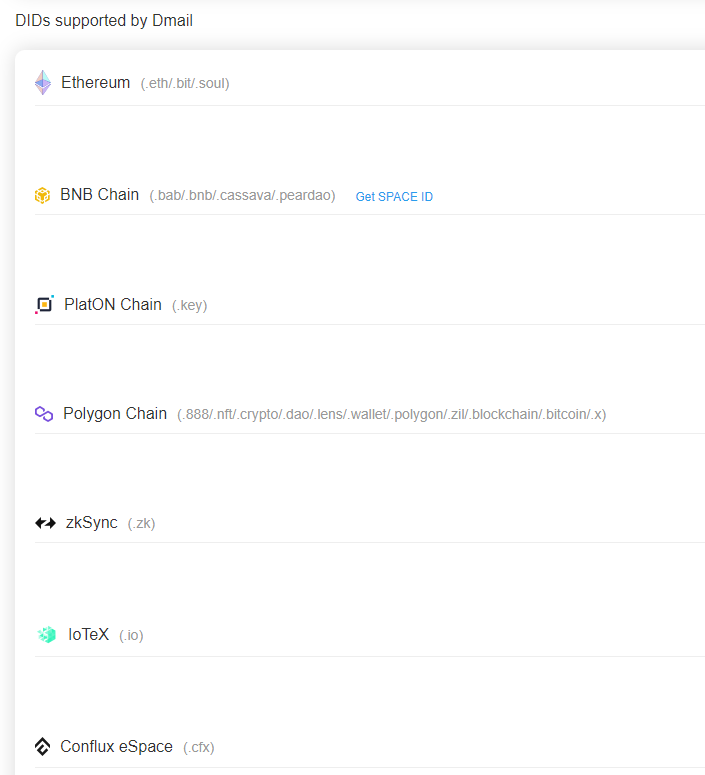Mail to Earn represented by Dmail still has two issues to solve: on the one hand, how many users will care about whether the emails they send are truly implemented with "decentralized storage"? On the other hand, how many users will use email to manage and send their on-chain assets?
Authors: Mia, Nianqing
This article was published in July 2023
On July 24th, the multi-chain Web3 infrastructure Dmail Network announced the completion of its Pre-A round of financing, with participation from Amino Capital, OIG VC, Draper Dragon, KuCoin Labs, and others. According to Rootdata, Dmail received seed and strategic round financing in December 2021 and February 2022, with support from well-known institutions such as Hashkey Capital and Kucoin Labs.
In addition, with the recent launch of its native token $ARKM on Binance Launchpad and the stimulus of airdropping points to early users, Web3 tool product Arkham has also gained attention, sparking enthusiasm for "Mail to Earn" for Dmail once again.
Currently, Dmail has over 550,000 active users, and according to Dune data, the daily transaction volume on the BNB Chain has recently exceeded ten thousand transactions, showing a significant increase in user interaction.

So, what exactly is Dmail? How is its current development? What are the rules of its point system? This article will quickly help you understand.
I. What is Dmail?
Dmail was launched in 2021, initially as a native project launched on the then-popular public chain DFINITY. However, as the narrative of DFINITY waned, Dmail embarked on a multi-chain development path and was adept at chasing industry hotspots in the crypto world. Starting in 2021, the project team was very fond of emphasizing that Dmail is a "NFT-ized mailbox," and earlier this year, taking advantage of the hot trend of AI narratives, Dmail announced its integration with ChatGPT and launched the "AI Mail Assistant" feature, helping users write email content through simple commands, and Dmail's positioning also changed to "Your AI assistant." When Conflux and Worldcoin were on fire, Dmail quickly announced its integration with them…
Similar to traditional mailboxes that use a unique email address to identify users, Dmail uses the user's on-chain address as the email address. Additionally, Dmail is also an NFT-ized mailbox, with each mailbox name representing an NFT. To protect the privacy and security of users using on-chain addresses, Dmail has introduced an alias system to manage user addresses. Users can replace their on-chain address with a mail account by setting an alias, thus protecting the privacy of their on-chain address.
Specifically, Dmail will implement functions such as message communication, asset management, data storage, subscriptions and notifications, Web3 marketing, and AI assistants.
1. Message Communication
According to the official introduction, Dmail focuses on integrating existing email technology with distributed technology, rooted in the technical principles of traditional email, while also integrating decentralized technology. Users can send and receive messages while using various additional functions.
Dmail's messages are divided into titles and bodies, with the title stored "on-chain" in the form of a hash value. The email body is encrypted using a key and stored in multiple decentralized storage locations to achieve rapid expansion and secure storage.
In terms of usage, Dmail's interface and operation are similar to traditional email. Upon entering the page, the main interface is the location of the inbox, with the left-hand function bar divided into two parts. The upper half is the common email communication function, and the lower half includes NFT market, asset management, domain purchase, and other Web3 functions.
As the official introduction states, using Dmail can either use normal email technology to communicate with Web2 mailboxes or use distributed technology to communicate with on-chain addresses. The email system will automatically categorize and tag emails sent from different systems, such as DID (binding ENS or purchasing Dmail domain), Web2 (normal email addresses, such as Gmail, Netease, etc.), and Web3 (users who default to using Web3 wallet addresses) (as shown in the figure below). According to ChainCatcher's test, there is nearly a 10-minute delay when using Dmail to send emails to Web2 mailboxes such as Gmail, while emails sent to DID and Web3 type addresses are received and sent in real-time.

2. Data Storage
Traditional emails are ultimately stored on the servers of domain companies, which exposes personal emails to the risk of leakage or loss. In terms of storage and security, Dmail uses decentralized storage to ensure that emails are always stored in the network, accessible at any time, while minimizing the risk of email content leakage. (Stored in which project and integrated with which decentralized protocol?)
3. Asset Management (Not yet online)
According to the official introduction, Dmail will also transform its positioning from a single information exchange platform to a comprehensive investment platform. In the later stage, the official plans to integrate wallet functions into the email system based on a massive amount of project information. Users can obtain project information through email and also send, receive, or transfer encrypted assets in the wallet through email, thereby completing on-chain encrypted transactions. In addition, they can also participate in airdrops or complete initial purchases of items through email.
4. Subscriptions and Notifications (Not yet online)
In addition, similar to traditional Web2 mailboxes, Dmail has also launched similar subscription and notification functions. According to the introduction, its push system will integrate project information on the market, making it convenient for investors to obtain. Users can subscribe to project-related information in the system to obtain project asset and airdrop information. However, the current version does not show a module similar to the upcoming release.
II. Dmail's Ecological Map
Data shows that since the launch of the Beta network on June 1, 2022, in just over a year, Dmail has registered nearly 550,000 domain accounts and over 300,000 personal addresses, and the platform has processed a total of 8.5 million messages. It has established partnerships with over 100 projects such as Worldcoin, ENS, SpaceID, Lens, zkSync Era, and BNB Chain.
1. Multi-chain Wallet Account System
Just this month, Dmail has achieved a major upgrade of its email account system, launching a wallet address-based account system, simplifying the email registration process. Users can directly establish a free email account using a wallet address and connect the wallet to generate an email address in the format of 0x000@dmail.ai (wallet address + suffix), which can be used to communicate with other Web2 and Web3 mailboxes.
As of now, Dmail is compatible with various networks, including EVM networks such as Ethereum, zkSync Era, BNB Chain, Polygon, Conflux, KCC, and LoTex, and non-EVM networks including Manta Network, StarkNet, Solana, Sei Network, and Dfinity.
2. DID Domain System
At the beginning of this year, Dmail launched its DaaS service. Users with any DID account can freely mint a Dmail NFT domain account when logging into Dmail. After logging in, users can view all DID names in the settings page and set them to be bound to any DID name for sending and receiving emails.

Currently, Dmail supports domain logins using ENS, SpaceID, JazDID, HashkeyID, Unstoppable, and .Bit, and plans to add more domain projects in the future.
After logging in with a wallet, users can browse all domain NFTs they own in the NFT Market interface and choose one to bind to their email system. After successful binding, they can use a custom domain address to send and receive emails. Users who already own domain addresses only need to spend gas fees to bind 8-11 character domain names.
Users who have not purchased domain NFTs on the above networks can also purchase domain names within the internal presale system of Dmail to bind to their existing email systems.

3. Integration with ChatGPT, Launch of AI Mail Assistant
Dmail's AI Mail Assistant integrates ChatGPT functionality to intelligently analyze email scenarios through AI and automatically match email types based on user descriptions, enabling intelligent email sending and receiving. Users can also use custom text requests (limited to 200 characters) to have AI assist in editing email content and layout. In addition, when replying to emails, AI will generate intelligent replies based on the original text (limited to 800 characters), making it convenient for users to adjust flexibly.
4. Deep Collaboration with Worldcoin
In May of this year, Dmail announced a deep collaboration with Worldcoin, becoming the first infrastructure protocol and application in the Web3 field to deeply collaborate with Worldcoin. Dmail will provide encrypted email, communication, AI marketing, and other services for Worldcoin's global users around WorldID. In the future, the two parties will also collaborate to launch an exclusive DID identity system, forming a unique binding relationship between individuals, WorldID, and Dmail accounts, jointly creating a global digital citizen infrastructure.
Currently, Worldcoin users can directly access Dmail and freely mint 8-11 character NFT domain mailboxes. Dmail has also set up a points reward program, where users can earn points by registering for the World APP through Dmail and verifying their email.
III. Dmail Points System
In October of last year, Dmail officially launched its points feature, officially starting the Mail to Earn journey.
Currently, methods to earn Dmail points include:
Purchasing paid email domain names to earn corresponding points (paying a 4-digit number earns 10,000 points automatically; paying a 5-digit number earns 5,000 points automatically; paying a 6-digit number earns 2,000 points automatically; paying a 7-digit number earns 800 points automatically; paying an 8-11 digit number earns 500 points by paying 5.49U).
Sending emails to Web2 users daily to earn corresponding points.
Sending emails to Web3 users daily to earn corresponding points.
Inviting new users to generate project points…
The specific rules are as follows:

It is worth noting that currently, if users use non-EVM networks such as StarkNet, Sei, etc., they must use a wallet compatible with their ecosystem to log into Dmail. This means that their email account is not the same as their EVM network account, so points cannot be accumulated here (this may also be a problem that must be solved in the development of DID).
In addition, Dmail also divides different permissions based on domain name levels. For example, if I pay 5.49U to purchase an 8-11 character domain NFT, I automatically receive 500 points and achieve Basic level. Therefore, I can send a maximum of 40 emails per day, with a maximum storage capacity of 200M, and the points earned are default points. If I upgrade to Premium level, in addition to an increase in email capacity, I can earn 1.1 times the points when earning points. Conversely, users who have not paid (only wallet login) can only earn 0.5 times the points.
Dmail's points also have a practical function. When the points reach a certain withdrawal limit, they can be bound to NFT, allowing users to upgrade their email usage permissions accordingly.
Conclusion
Currently, in addition to Dmail, there are other projects in the market such as Skiff, Mail3.me, MetaMail, etc. However, these projects are more focused on traditional email functions such as "information communication and notification," and apart from emphasizing privacy features and supporting encryption of emails and inboxes, they have not been involved in the expansion and development of more Web3 applications. It must be said that Dmail is more intelligent in terms of product marketing and market perspective.
With the addition of its asset management function in the future, its Web3 attributes will be further enhanced. However, apart from the expected airdrops and short-term incentives, has Dmail really captured the pain points of users at this stage? It is worth considering: on the one hand, how many users will be more concerned about whether the emails they send are truly implemented with "decentralized storage"? On the other hand, how many users will use email to manage and send their on-chain assets?
免责声明:本文章仅代表作者个人观点,不代表本平台的立场和观点。本文章仅供信息分享,不构成对任何人的任何投资建议。用户与作者之间的任何争议,与本平台无关。如网页中刊载的文章或图片涉及侵权,请提供相关的权利证明和身份证明发送邮件到support@aicoin.com,本平台相关工作人员将会进行核查。




